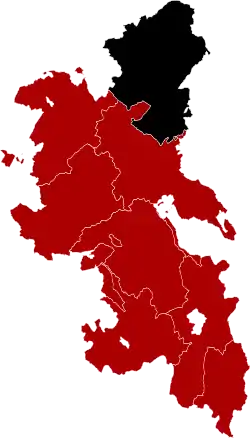52°06′43″N 0°45′39″W / 52.11194°N 0.76083°W
| Newport Hundred | |
|---|---|
 | |
| Area | |
| • 1861 | 74,481 acres (301.41 km2)[1] |
| Population | |
| • 1861 | 30,226.[2] |
| History | |
| • Created | 13th century[3] |
| • Abolished | 1880s |
| Status | Hundred |
| • HQ | Gayhurst |
| Subdivisions | |
| • Type | Parishes |
Newport Hundred was a hundred in the county of Buckinghamshire, England. It encompassed the north of the county, enclosed by the counties of Bedfordshire and Northamptonshire and the Buckinghamshire hundreds of Aylesbury and Buckingham. It was commonly known as "the three hundreds of Newport" because it amalgamated three earlier (11C) hundreds: Bonestou (or Bunsty), Moulsoe and Siglelai (or Seckley/Seckloe/Secklow). Its modern equivalent is the Borough of Milton Keynes, which covers almost exactly the same area (plus a little of the former Winslow Hundred, itself one of 18 ancient hundreds amalgamated under the administrative control of Cottesloe Hundred).
History
Until at least the time of the Domesday Survey in 1086 there were 18 hundreds in Buckinghamshire. It has been suggested however that neighbouring hundreds had already become more closely associated in the 11th century so that by the end of the 14th century the original or ancient hundreds had been consolidated into 8 larger hundreds.[4] Newport became the name of the hundred formed from the combined 11th century hundreds of Bonestou, Moulsoe and Sigelai;[3] these original names still persisted in official records until at least the early part of the 17th century. The court leet and "three weeks court" for Newport Hundred were usually held at Bunsty (now part of Gayhurst); in 1830 they also took place at the Swan Inn in Newport Pagnell.[3]
Traces of the moot hill of Sigelai Hundred were discovered by archaeologists working for Milton Keynes Development Corporation, during the construction of Central Milton Keynes;[5] the site is a Scheduled Ancient Monument and lies behind the central library.[6]
Parishes and hamlets
Newport hundred comprised the following ancient parishes and hamlets, (formerly medieval vills), allocated to their respective 11th century hundred:[3]
See also
References
- ↑ Vision of Britain - Newport Area Retrieved, May 22, 2009
- ↑ Vision of Britain - Newport Population Retrieved, May 22, 2009
- 1 2 3 4 History on Line - Victoria County History - A History of the County of Buckingham - Newport Hundred: Volume 4, (1927), pp. 268-269. Retrieved, May 22, 2009
- ↑ Genuki - History of Buckinghaham Hundreds Archived 2009-08-23 at the Wayback Machine Retrieved, May 21, 2009
- ↑ Adkins, R; Petchey, M. (1984). "Secklow hundred mound and other meeting place mounds in England". Archaeological Journal. 141: 243–251. doi:10.1080/00665983.1984.11077777.
- ↑ Historic England. ""Secklow Hundred mound: a moot at the junction of North Row and North Ninth Street" (1007940)". National Heritage List for England.